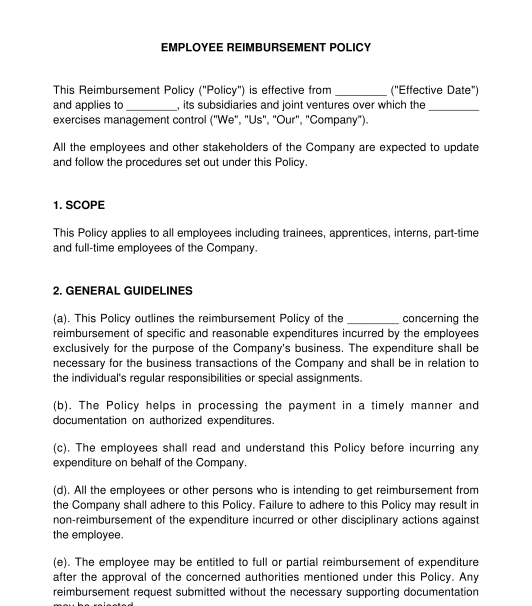 04-01-2025
04-01-2025

Answer a few questions and your document is created automatically.

Your document is ready! You will receive it in Word and PDF formats. You will be able to modify it.

 04-01-2025
04-01-2025
 Word and PDF
Word and PDF
 5 to 8 pages
5 to 8 pages
The Employee Reimbursement Policy is a document that specifies the expenses that will be refunded to an employee that are spent on behalf of the organization. Employees may need to pay for certain work-related expenses themselves, including travel expenses, hotel expenses, stationary expenses, etc. This policy can be used by any type of organization, despite its size or type of business, including a company, LLP, or partnership.
The Employee Reimbursement Policy is referred to whenever an employee incurs expenses on behalf of the organization, such as travel, lodging, meals, supplies and other costs related to conducting business activities.
No, it is not mandatory. However, having a clear Employee Reimbursement Policy helps to standardize the reimbursement process, prevent fraud, and avoid any potential disputes in future.
Any employee who incurs a legitimate business expense while working for the organization can claim the reimbursement. The employees must be those who have entered into a employment agreement with the organisation. This includes full-time, part-time, and temporary employees. In some cases, the organization may allow contractors to claim reimbursement.
Once the policy is drafted, it can be circulated to the employees through electronic medium or in physical copies. The organization may ask the employees to acknowledge this policy and send it back for record purposes. It is better to incorporate this document in employment agreements and get it signed at the time of joining the organization.
It is always better to make the policy accessible to all employees of the organization and update them whenever there are any changes made to it.
This Employee Reimbursement Policy can be used as a supplementary document to an Employment Agreement, Employee Code of Conduct Policy, Non-Compete Agreement, Non-Disclosure Agreement, Remote Work Policy, Employee Privacy Policy, Employee Disciplinary Policy, etc.
This Employee Reimbursement Policy covers the following important areas:
The Employee Reimbursement Policy may be covered under the applicable state labour laws.
You fill out a form. The document is created before your eyes as you respond to the questions.
At the end, you receive it in Word and PDF formats. You can modify it and reuse it.
Employee Reimbursement Policy - Template - Word and PDF
Country: India